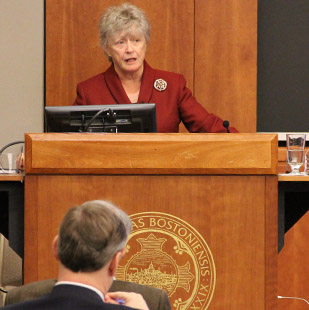Bicknell Lecturer Calls for Transforming Approach to Pain.
It meets all the criteria of a public health epidemic: millions of people affected, billions of dollars expended, pronounced disparities, and action needed in both prevention and intervention.
Chronic pain: an orphan condition in the U.S. health system.
“We [need to] talk about the extent of pain, and the extent to which it is clearly a public health problem, but not recognized as a public health problem,” said Noreen Clark, PhD, director of the Center for Managing Chronic Disease at the University of Michigan, who delivered the 2012 William J. Bicknell lecture at the BU School of Public Health. “A population-based strategy is needed to reduce pain and its consequences. We need a cultural transformation in the way we deal with pain in this country.”
 Noreen ClarkClark, who served as co-chair of a 2011 Institute of Medicine (IOM) committee that examined the extent of pain in America, said there are moral, medical and financial reasons for policymakers and clinicians to revamp the way chronic pain is managed — not the least of which is that it affects more than 100 million people, at an estimated cost of $560 billion to $635 billion.
Noreen ClarkClark, who served as co-chair of a 2011 Institute of Medicine (IOM) committee that examined the extent of pain in America, said there are moral, medical and financial reasons for policymakers and clinicians to revamp the way chronic pain is managed — not the least of which is that it affects more than 100 million people, at an estimated cost of $560 billion to $635 billion.
The social implications are far-reaching, she said: Pain affects ability to work, mood, activities of daily living, and relationships.
Clark recounted the story of a clinical social worker who would go to the ER for episodes of pain and feel ashamed to be seeking treatment. “I’ll put on my hospital gown and lose my social status and identity,” the patient told the IOM committee. “I’ll become a blank slate for doctors” to project their biases on.
“There’s stigma associated with pain — even sometimes when the cause of the pain is understood,” Clark said.
The IOM committee made a number of recommendations to improve the way pain is addressed, including better training for providers, more treatment options, and changes to insurance coverage to allow for alternative therapies, such as nutrition counseling, physical therapy, massage and meditation.
“Quite frankly, there are as many studies that demonstrate the efficacy of these approaches as there are for opioids,” Clark said.
Clark and three panelists who joined her at the event offered wide-ranging views on one of the most controversial aspects of pain management: the use of opiates. The IOM report, while not delving into opiate use, prompted debate in the medical community about the reliance on pharmaceuticals, with some pain specialists concerned about under-treating pain, and some physicians and addiction specialists concerned with over-treating pain. Clark said both concerns were valid, but that the IOM review showed a higher likelihood that chronic pain is undertreated.
“We need to recognize that it’s overlooked, undertreated, and people are stigmatized and categorized… and we’re not going to improve the way we assess it and treat it unless we address this perception problem,” she said.
She cited estimates that 43 percent of adults suffer from some common chronic pain condition, and she noted that African-Americans, Hispanics and the elderly were “at risk for under-treatment, in general,” in medical care.
The panelists included Madeleine Biondolillo, MD, director of the Bureau of Health Care Safety and Quality of the state Department of Public Health, who discussed the state’s prescription monitoring program, which tracks the dispensing of controlled substances. The program flags patients who receive prescriptions from multiple providers and multiple pharmacies.
She said the department — concerned about an increase in drug-induced deaths in recent years — hopes the prescription monitoring program will help clinicians identify prescription drug abusers.
Barbara Herbert, MD, chief of the division of addiction medicine at St. Elizabeth’s Medical Center, said addiction often is caused by attempts to manage pain. She said treatment for addiction “has to be more readily available if we’re going to take on [opiate abuse] as a public health problem.” Group interventions, such as Alcoholics Anonymous and Narcotics Anonymous, are valuable, she said.
She noted that addressing prescription drug abuse is complicated because it involves the law enforcement system, as well as the healthcare system.
Richard Laing, MD, of the World Health Organization, said low- and middle-income countries deal with drug shortages routinely, and that opiate consumption is much higher in the U.S. than in the rest of the world. About 4.7 billion people live in countries where medical opiate use is close to zero — cultures in which, Laing said, “pain isn’t treated; it’s normal.”
BUSPH Dean Bob Meenan said he agreed that chronic pain deserves attention in research, education and practice.
“I can certainly see a real engagement of public health on this issue,” he said.
The annual Bicknell lecture honors William Bicknell, founder of the BUSPH Department of International Health, who died in June.
Submitted by Lisa Chedekel chedekel@bu.edu